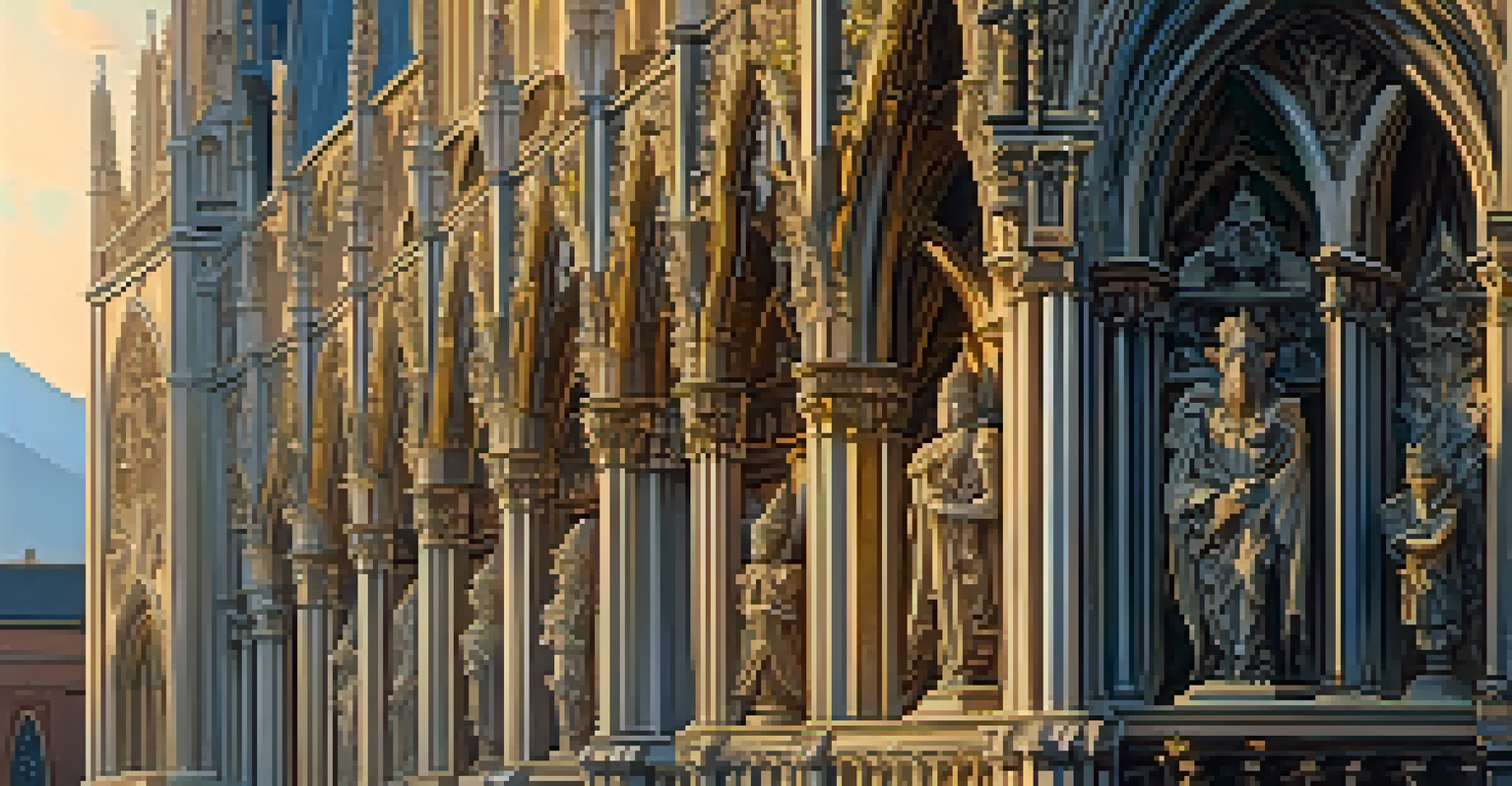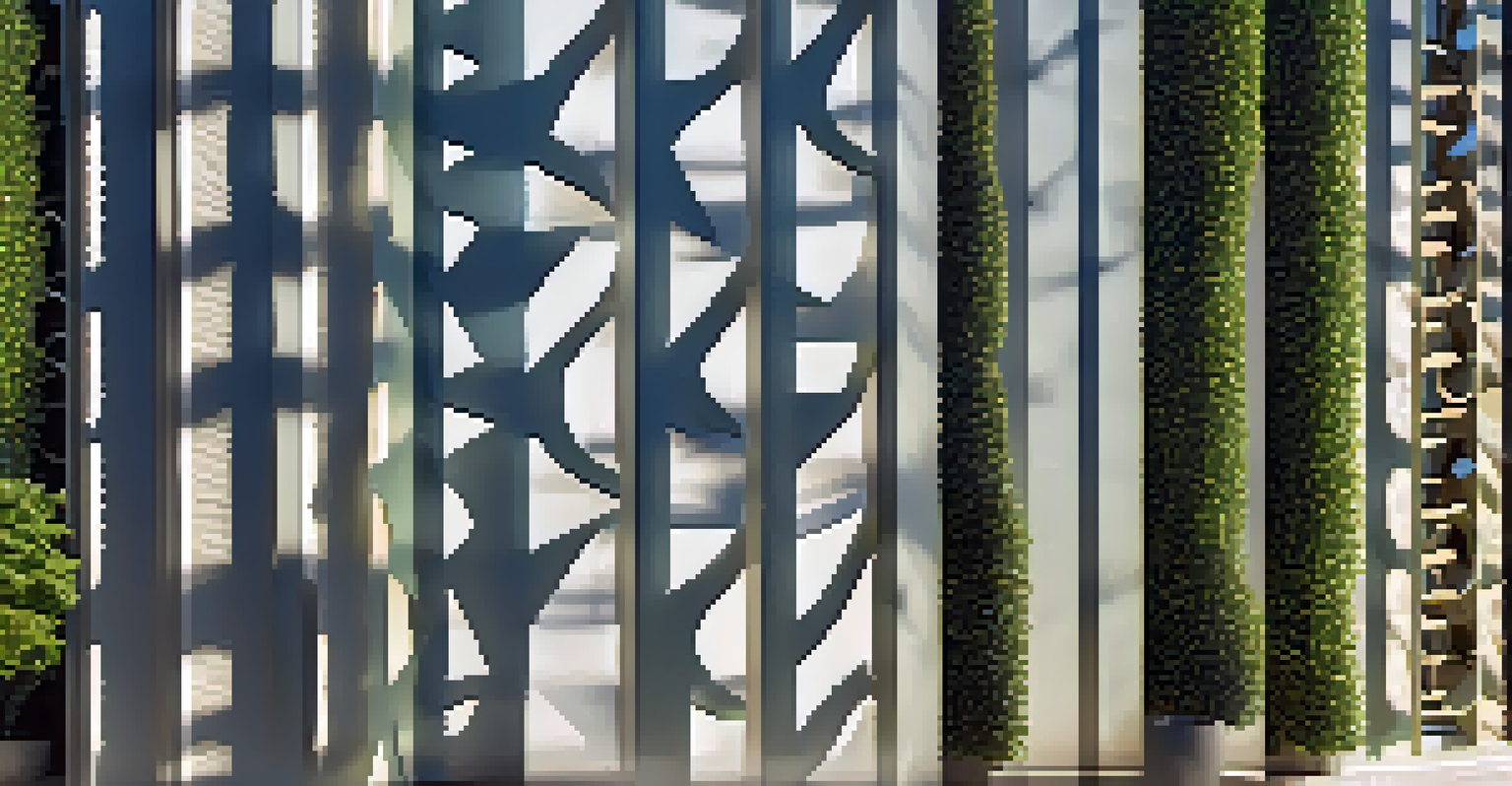Carving in Architecture: A Reflection of Cultural Identity

Understanding Architectural Carving and Its Significance
Architectural carving is an art form that involves sculpting materials like stone, wood, or plaster to create intricate designs. This practice has played a crucial role in various cultures, acting as a visual language that communicates stories, traditions, and beliefs. From ancient temples to modern structures, the carvings often reflect the identity of the community that created them.
Art is the most beautiful of all lies; it is a truth that we can understand through our emotions and our experiences.
For instance, the ornate carvings found in Hindu temples showcase deities and mythological narratives, revealing deep spiritual connections. Similarly, Gothic cathedrals feature gargoyles and other figures that serve both decorative and functional purposes. These elements not only beautify structures but also provide insight into the cultural and historical context of their time.
In essence, architectural carving serves as a bridge connecting generations, allowing us to appreciate the artistry and craftsmanship of the past. As we explore this topic further, we will see how these carvings symbolize cultural identity and reflect the values of different societies.
Historical Roots: Carving in Ancient Civilizations
The practice of carving in architecture can be traced back to ancient civilizations such as the Egyptians, Greeks, and Romans. Each of these cultures utilized carving to express their beliefs and showcase their artistic prowess. For example, the Egyptians adorned their temples with hieroglyphics and reliefs that told stories of gods and pharaohs, effectively immortalizing their cultural narratives in stone.

Greek architecture, on the other hand, emphasized harmony and proportion, with intricate friezes depicting mythological scenes. The Parthenon in Athens is a prime example, where the sculptural work not only served an aesthetic purpose but also communicated the values of democracy and civic pride. Such carvings were pivotal in demonstrating the sophistication of these ancient societies.
Cultural Significance of Carving
Architectural carving serves as a visual language that reflects a community's identity and cultural values.
As we delve into history, it becomes apparent that these carvings were more than just decorative features; they were essential in preserving the identity and values of a community. Understanding these historical contexts allows us to appreciate how these ancient techniques have influenced contemporary architecture.
Cultural Variations: Carving Styles Across Regions
Carving styles vary significantly across different cultures, each reflecting unique artistic traditions and values. For instance, Islamic architecture is renowned for its intricate geometric patterns and calligraphy, often seen in mosques and palaces. These designs serve as a form of spiritual expression, emphasizing the beauty of the divine and the importance of community.
The details are not the details. They make the design.
In contrast, Indigenous cultures often incorporate natural elements into their carvings, using local materials to depict animals, spirits, and ancestral figures. These carvings are deeply rooted in cultural narratives and serve as a means of preserving history and tradition. For example, totem poles of the Pacific Northwest tell stories of lineage and community values, showcasing the integral relationship between art and identity.
Such variations illustrate how carving is not just an artistic endeavor but a reflection of the environment and societal beliefs. By examining these diverse styles, we gain insight into how different cultures articulate their identities through architectural carving.
Modern Interpretations: Carving in Contemporary Architecture
In contemporary architecture, carving has evolved to embrace new materials and technologies, allowing for innovative designs that still honor cultural identity. Modern architects often blend traditional carving techniques with contemporary aesthetics to create unique structures that resonate with local communities. For instance, buildings may feature laser-cut patterns that mimic traditional motifs, bridging the past and present.
Additionally, sustainability has become a driving factor in modern architectural carving. Many architects now prioritize eco-friendly materials and practices, ensuring that their designs respect both cultural heritage and the environment. This approach not only enhances the visual appeal of buildings but also reinforces their connection to the community.
Challenges to Traditional Techniques
Traditional carving practices face threats from globalization and urbanization, risking the loss of unique cultural craftsmanship.
As we navigate this modern landscape, it’s fascinating to see how architects draw inspiration from historical carving while pushing the boundaries of creativity. The interplay between tradition and innovation highlights the ongoing importance of cultural identity in architectural practices today.
The Role of Carving in Cultural Preservation
Carving plays a vital role in the preservation of cultural heritage, acting as a tangible link to the past. Many communities strive to maintain traditional carving techniques as a way to honor their history and educate future generations. Workshops and cultural events often showcase these skills, fostering a sense of pride and connection among artisans and the broader community.
For example, the revival of traditional Indian stone carving has gained momentum in recent years, with artisans passing down their knowledge through apprenticeships. This not only keeps the craft alive but also strengthens community ties and cultural identity. Such initiatives highlight the importance of preserving these artistic practices as they are integral to the narrative of a culture.
Through carving, communities can celebrate their unique identities while also adapting to modern influences. This dynamic process of cultural preservation ensures that the stories and values embedded in these carvings continue to resonate with future generations.
Challenges Facing Traditional Carving Practices
Despite its significance, traditional carving practices face numerous challenges in the modern world. Globalization has led to a dilution of unique cultural identities, as mass-produced designs often overshadow traditional craftsmanship. As a result, many skilled artisans struggle to find their place in a rapidly changing market, risking the loss of invaluable techniques and knowledge.
Additionally, urbanization and industrialization have transformed landscapes, leading to a decline in traditional architecture that once featured intricate carvings. As cities expand, many historical buildings are demolished or altered, erasing the stories and identities they once represented. This shift highlights the urgent need for preservation efforts to protect cultural heritage.
Future of Carving in Architecture
The integration of modern technologies with traditional carving methods can create innovative designs that honor cultural heritage.
By addressing these challenges, we can better support artisans and ensure that traditional carving continues to thrive. Advocacy for the importance of cultural heritage in architecture is essential, and communities must come together to celebrate and preserve their unique artistic legacies.
The Future of Carving in Architecture: A Cultural Journey
As we look to the future, the role of carving in architecture will likely evolve while remaining deeply rooted in cultural identity. New technologies, such as digital fabrication and 3D printing, offer exciting possibilities for integrating traditional designs into modern structures. This fusion of cutting-edge techniques with time-honored practices can create unique architectural expressions that honor cultural narratives.
Moreover, the increasing focus on sustainability and cultural sensitivity in architecture encourages a resurgence of interest in traditional carving methods. Architects and designers are recognizing the value of local craftsmanship, often collaborating with artisans to create buildings that reflect the identity of their surroundings. This collaboration fosters a deeper understanding and appreciation of cultural heritage.

Ultimately, the future of carving in architecture is a journey that intertwines innovation and tradition. By embracing both, we can create spaces that not only tell stories but also celebrate the rich tapestry of cultural identities that shape our world.